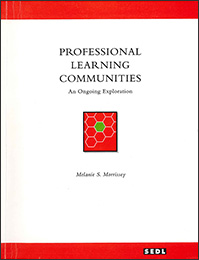Final Thoughts

Professional learning communities are a balance between organizational structure and productive, substantive use of that organization and time. The principal’s role is a critical one, orchestrating a delicate balance between support and pressure, encouraging teachers to take on new roles while they themselves let go of old paradigms regarding the role of school administrator.
As educators are continually striving to provide appropriate learning environments for children, so too must we be cognizant of providing similar environments for our teachers. In this paper, we have shared SEDL’s learning regarding the need for communities of continuous inquiry and improvement, as well as the structures and conditions that are required to nurture the development of professional learning communities in schools. It is hoped that these findings will be pushed forward in the field, identifying more strategies for school staffs to use in advancing toward development of communities of continuous inquiry and improvement, and improving student learning in their schools.
References
- Carmichael, L. (1982, October). Leaders as learners: A possible dream. Educational Leadership, 40(1), 58—59.
- Darling-Hammond, L. (1996, March). The quiet revolution: Rethinking teacher development. Educational Leadership, 53(6), 4-10.
- Darling-Hammond, L. (1998). Teachers and teaching: Testing policy hypotheses from a national commission report. Educational Researcher, 27(1), 5-15.
- DuFour, R., & Eaker, R. (1998). Professional learning communities at work: Best practices for enhancing student achievement. Bloomington, IN: National Education Service.
- Eastwood, K., & Louis, K. (1992). Restructuring that lasts: Managing the performance dip. Journal of School Leadership, 2(2), 213-224.
- Elmore, R. F. (2000). Building a new structure for school leadership. Washington, D.C.: Albert Schanker Institute.
- Fullan, M. G., & Miles, M. B. (1992). Getting reform right: What works and what doesn’t. Phi Delta Kappan, 73(10), 744-752.
- Garmston, R. J., & Wellman, B. M. (1999). The Adaptive School: A sourcebook for developing collaborative groups (p. 56). Norwood, MA: Christopher-Gordon Publishers.
- Hord, S. M. (1992). Facilitative leadership: The imperative for change. Austin, TX: Southwest Educational Development Laboratory.
- Hord, S. M. (1997). Professional learning communities: Communities of continuous inquiry and improvement. Austin, TX: Southwest Educational Development Laboratory.
- Lee, V. E., Smith, J. B., & Croninger, R. G. (1995, Fall). Another look at high school restructuring. Issues in restructuring schools. Madison, WI: Center on Organization and Restructuring of Schools, School of Education, University of Wisconsin-Madison.
- Leithwood, K., & Louis, K. S. (1998). Organizational learning in schools: An introduction. In K. Leithwood & K. S. Louis (Eds.), Organizational learning in schools (pp. 1-14). Lisse, the Netherlands: Swets & Zeitlinger.
- Leo, T., & Cowan, D. (2000). Launching professional learning communities: Beginning actions. Issues…about Change, 8(1).
- Little, J. W. (1997). Excellence in professional development and professional community. Washington, D.C.: Office of Educational Research and Improvement.
- Martel, L. D. (1993, June). Building a learning community: School leaders and their organizations need to share a vision to challenge all young minds. School Administrator, 50(6), 22-27.
- Morrissey, M. S. (2000). Comprehensive school improvement: Addressing the challenges. Issues…about Change, 9(1).
- Newmann, F. M., & Wehlage, G. G. (1995). Successful school restructuring. Madison, WI: Center on Organization and Restructuring of Schools, School of Education, University of Wisconsin-Madison.
- Reyes, P., Scribner, J. D., & Paredes Scribner, A. (Eds.). (1999). Lessons from high-performing Hispanic schools: Creating learning communities. New York: Teachers College Press.
- Senge, P. (1990). The fifth discipline: The art and practice of the learning organization. New York: Doubleday Currency.
- Senge, P. (2000). Schools that learn: A fifth discipline fieldbook for educators, parents, and everyone who cares about education. New York: Doubleday Currency.
- Sirotnik, K. A. (1999). Making sense of educational renewal. Phi Delta Kappan, 80(8), 606-610.
- Smylie, M. A., & Hart, A. W. (1999). School leadership for teacher learning and change: A human and social capital development perspective. In. J. Murphy & K. S. Louis (Eds.), Handbook of research on educational administration (2nd Ed., pp. 421-441). San Francisco: Jossey-Bass.
- Thiessen, D., & Anderson, S. E. (1999, April). Transforming learning communities: Getting into the habit of change in Ohio schools—The cross-case study of 12 transforming learning communities. Toronto: Ontario Institute for Studies in Education of the University of Toronto.
- Wald, P. J., & Castleberry, M. S. (Eds.). (2000). Educators as learners: Creating a professional learning community in your school. Alexandria, VA: Association for Supervision and Curriculum Development.
Acknowledgment
Written by Melanie S. Morrissey, Program Associate and Coordinator with SEDL's Small Learning Communities (SLC). The SLC program's primary objective is to support large high schools that have been granted federal funds for the development of smaller learning communities on their campuses. Ms. Morrissey is responsible for managing the planning and implementation of program activities provided for and with the SLC grantees in the southwestern region.
This publication was produced in whole or in part with funds from the Office of Educational Research and Improvement, U.S. Department of Education, under contract #RJ96006801. The content herein does not necessarily reflect the views of the Department of Education, any other agency of the U.S. Government or any other source.

